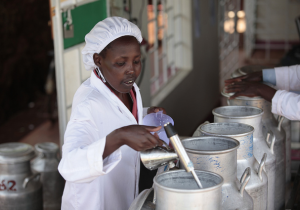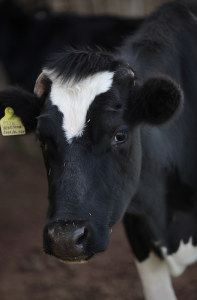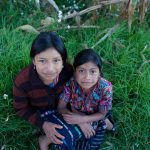This article by Esha Chhabra discusses the grant awarded to the East Africa Dairy Project by Gates Foundation, a featured SOCAP12 keynote speaker – Markets for Good: Upgrading the Social Sector. The article was originally published by SOCAP12 media partner, Dowser. Look for more stories from Dowser out of SOCAP12.
–
 Joan Kimeli, the recording clerk at the Metkei Multipurpose Company Limited in Kenya uses a alcohol gun to inspect freshness in milk in Kamwosor Centre village on Monday May 16, 2011. (Photo Courtesy of Heifer)
Joan Kimeli, the recording clerk at the Metkei Multipurpose Company Limited in Kenya uses a alcohol gun to inspect freshness in milk in Kamwosor Centre village on Monday May 16, 2011. (Photo Courtesy of Heifer)
Recently, the Gates Foundation awarded Heifer International with an additional $8.5 million for the East Africa Dairy Project. We speak with Elizabeth Bintliff, Vice President of Heifer’s Africa Program.
First of all, everyone wants to know how these new funds will be used and how does the $8.5 million grant translate into results on the ground?
The grant from the Bill & Melinda Gates Foundation funds the East Africa Dairy Development project, which has been going on since 2008. Through this project, about 179,000 families who are involved in dairy farming can improve the profitability of the small farming endeavors through enterprise and by gaining greater access to markets. In practical terms, the creation or strengthening of Dairy Farmer business Associations, the establishment of chilling plants which are critical for milk storage and transportation to processors, the establishment of dairy hubs that mean farmers have access to the necessary inputs to make their farms more productive: veterinary supplies, water, feed, artificial insemination services, etc. What this translates to is not just improved income, but improved livelihoods for these families: income to pay school fees, medical bills and other household expenses.
The association with the Gates Foundation has been tremendous for Heifer and has been a very mutually beneficial partnership. What this grant has afforded us is the ability to help a greater number of farmers than ever before in any single Heifer project. It has also afforded us the ability to test a theory on scale and its relationship with impact. We have learned that we can still implement large projects and do so without compromising their success.
We have learned to engage with the private sector in a different way. Ultimately, for many development projects, it is the ability of the private sector to absorb the objectives of the project that underpin its sustainability. We’ve learned to measure our impact more intentionally and analyze our work more critically.
 Why is the cow the solution? Why not other livestock or agriculture? Is there a particular reason why cows are the ideal solution?
Why is the cow the solution? Why not other livestock or agriculture? Is there a particular reason why cows are the ideal solution?
From the market perspective, there is a growing need for increased agriculture and livestock production levels across Africa. More specifically, evidence points to increasing market demand for dairy products in Eastern Africa. Overall, the FAO predicts milk production will more than double from 216 million metric tons in 2000 to 475 million metric tons by 2030 in developing nations. An expected rise in prosperity and purchasing power among middle and lower-income consumers in emerging markets, such as Eastern Africa, also points to growth in the industry over the next few years.
We work with governments, but we do not program our funds through governments. In each of our country programs we hire our own staff and have our own accountability infrastructures that enable us ensure that we are able to be good stewards of the funding that is so generously afforded us by our donors.
This addresses Heifer International’s key cornerstone of sustainability. It forces us to examine and employ strategies and activities that ensure continuity, including partnering and involving the private sector, the government and other stakeholders.
Perhaps the most important element in sustainability is beneficiary agency and ownership. Unless the people who stand to benefit from the project take an active involvement or stake in its success, the project’s sustainability is not assured.



